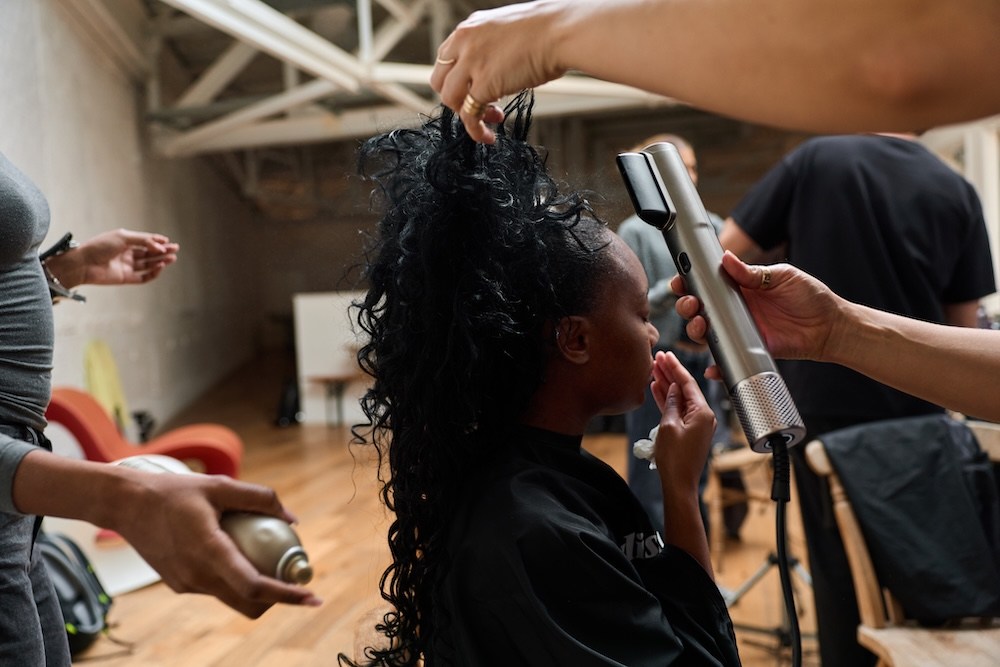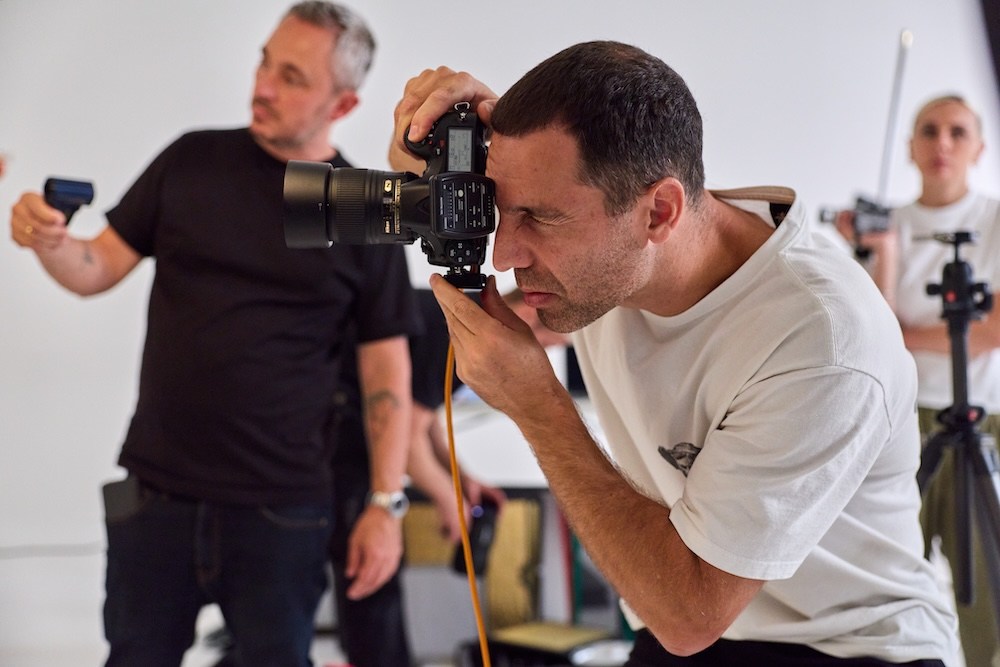
Future Tense
Partnership

Future tense styling with a Creative HEAD shoot, in partnership with BaBylissPRO
Artificial intelligence may be able to simulate almost anything, but for this project, we’re going back to reality, styling hair that’s so polished, so pristine, so unbelievably perfect, it’s surely an illusion… But it’s not.
In a Creative HEAD partnership shoot with BaBylissPRO, we fuse innovative technology for modern styling alongside the power of artistry and precision of hair professionals. This is hand-crafted hair – designed for future wear, powered by future tech.
Three inspirational hair artists, inspired by future-gazing, share their next-gen hair looks, all created with ground-breaking tools that serve as an extension of their own hands. No AI generation, no doctoring, minimal retouching.
Serving as the perfect juxtaposition, the skin and bodies of the models sporting those hair looks have been transformed courtesy of AI, showcasing that collision between authentic and digitized, crafted realism and automated enhancement.
The finest tools in hand.
Hair artistry at it most captivating.
Hand-crafted creativity is alive and kicking.
This is the future… and it’s electrified.


This stylist and men’s groomer – and newly crowned Most Wanted Session winner – has blossomed from a hungry salon junior into an internationally recognised (and busy!) session stylist, whose work has featured in the likes of Vogue, Harper’s Bazaar and Elle. She started assisting backstage at Fashion Week 10 years ago and now is killing it with her boundary-pushing work with DJ and activist Bimini. She has a passion for individualism and carefully nurtures relationships with muses and artists to collectively bring their visions to life.

A Most Wanted Session Stylist Legend, Syd has spent the past two decades masterfully working his way up the ranks of fashion’s most exciting talents, creating looks inspired by London’s youth driven culture. A global ambassador for BaBylissPRO, and the stylist-of-choice on set for numerous global Fashion Week shows and fashion bible editorials, Syd is adored for crafting bold, dynamic looks with an instinctive understanding of texture and character. All delivered with a cheeky grin and a can-do attitude. Has anyone ever seen Syd without a smile?

The Percy behind the Percy & Reed salon and haircare brand, this session veteran is a master in the world of music, styling some of the biggest artists across the past three decades. From the biggest publications to Fashion Week shows, video shoots to gigs, Paul has honed a reputation for simple, clean lines delivered with calm and charm. It’s no wonder artists such as the Spice Girls, Bjork, Kylie, Ellie Goulding and Calvin Harris have been in his hair hot seat.

Taking inspiration from a messed–up Barbie to classic Thierry Mugler, Lauren crafted textured looks that were playful, experimenting with shape in both organic and manufactured ways – fitting for the project’s digital vs real concept. “Where I’m coming from on this shoot is part of my inspiration was the look. Conceptually, the whole idea of AI is that it’s going back into the past, to everything that’s been created before, and using that as a resource to learn and improve. I love that idea, I think that’s beautiful,” she says. “It’s the idea of pushing things forward. It feels like growth. As people, all our experiences and that knowledge that’s in our head and our body, we feel it every day… then that goes into our work. The progression in my work as an artist comes from that from that place. There’s no future without the past; I love that it’s pushing us forward.”


“I went for a futuristic, past and present version of the disco era – lots of volume, but bringing in this sort of gritty, broken texture as well,” says Lauren. “Kind of like a Barbie that’s been shaved and put in the bin – but a cute version! This is a beautiful duality, bringing the past with you into your future and looking pretty.”
Key Process
Using the BaBylissPRO Drying Wand with the pik attachment to blow dry the hair out smoother, Lauren used hairspray and the wand again on cool to set the ponytail. Some strategic padding was added to build up the shape, checking regularly in the mirror and with a 360 degree view to ensure it felt right with the model’s head shape. Once happy with the padding and the shape, she added in some prepped hair extensions, cutting some as she styled. That organic placement of hair around the crown and face? Done by using the airflow from the Drying Wand and hairspray to set it as it blew out in different directions. It wasn’t uniform at all, and not too neat anywhere. Then everything was set with the Drying Wand and some salt spray.
Key Process: Using the BaBylissPRO Drying Wand with the pik attachment to blow dry the hair out smoother, Lauren used hairspray and the wand again on cool to set the ponytail. Some strategic padding was added to build up the shape, checking regularly in the mirror and with a 360 degree view to ensure it felt right with the model’s head shape. Once happy with the padding and the shape, she added in some prepped hair extensions, cutting some as she styled. That organic placement of hair around the crown and face? Done by using the airflow from the Drying Wand and hairspray to set it as it blew out in different directions. It wasn’t uniform at all, and not too neat anywhere. Then everything was set with the Drying Wand and some salt spray.
Tool Tip
“I used the smallest BaBylissPRO Curling Tongs in two different sizes – 13mm and 16mm – and purposefully alternated the direction going down the hair shaft and across my sectioning pattern to ensure that there were no uniform curls. I didn’t want a perfect curl, like you might have seen back in the ‘70s at the disco. This is reused Barbie and she’s not going to be pristine…”
Tool Tip: “I used the smallest BaBylissPRO Curling Tongs in two different sizes – 13mm and 16mm – and purposefully alternated the direction going down the hair shaft and across my sectioning pattern to ensure that there were no uniform curls. I didn’t want a perfect curl, like you might have seen back in the ‘70s at the disco. This is reused Barbie and she’s not going to be pristine…”


“The inspiration came from my initial thought process – when someone says ‘futuristic’, I think ‘90s Thierry Mugler,” says Lauren. Delving through the archives, she fused her model’s head’s silhouette with an elongated alien-inspired shape.
Key Process
Using the BaBylissPRO Drying Wand, Lauren was able to slick the hair back and then set it with hairspray to nail that silhouette. On top of that, she added braids – “very simplistic, which I think is futuristic” – and the result was beautiful. “You wouldn’t walk around like that – that’s what makes it futuristic,” smiles Lauren.
Using the BaBylissPRO Drying Wand, Lauren was able to slick the hair back and then set it with hairspray to nail that silhouette. On top of that, she added braids – “very simplistic, which I think is futuristic” – and the result was beautiful. “You wouldn’t walk around like that – that’s what makes it futuristic,” smiles Lauren.


As a contributor to the evolution of the new BaBylissPRO Drying Wand – he tested the various iterations from the labs in Paris, feeding back the insight that only a busy working stylist could share – Syd had already been pondering thoughts of what futuristic looks like, especially in textures and shapes. “’Future’ is shiny and glossy. The hair shouldn’t be matte, it should be, like, pumped, as if it’s been enhanced by AI. Of course, it hasn’t,” he says.


We’re looking forward, so Syd made sure this hair goes backwards! It’s aerodynamic, nodding to the shapes you see in science fiction, from spaceships to architecture. Yet one specific reference screams out (#SorryNotSorry) above the others – the acid-blooded HR Giger-designed creature from the iconic movie, ‘Alien’. When you do finally see her, it’s terrifying – mouth open, teeth bared, a laser-focused predator. This 1979 film gave us a vision of 2122; doesn’t feel that far forward now…
Key Process
A long, curved headpiece made of chicken wire was covered with the mesh from a cut up hair donut. Most of the model’s hair was blow dried back into a ponytail, using the Drying Wand – this would ultimately sit hidden within the wire headpiece. A front section of hair from ear to ear was left out and loaded with thickening spray to later blast dry smooth. Syd then grabbed the BaBylissPRO Stilista to smooth over some top sections and to ensure a graphic and shiny finish, spot on for the concept. That front section was pinned over the wire piece. A little cheat meant some hair extensions were added underneath to wrap over the piece and camouflage that wire.
A long, curved headpiece made of chicken wire was covered with the mesh from a cut up hair donut. Most of the model’s hair was blow dried back into a ponytail, using the BaBylissPRO Drying Wand – this would ultimately sit hidden within the wire headpiece. A front section of hair from ear to ear was left out and loaded with thickening spray to later blast dry smooth. Syd then grabbed the BaBylissPRO Stilista to smooth over some top sections and to ensure a graphic and shiny finish, spot on for the concept. That front section was pinned over the wire piece. A little cheat meant some hair extensions were added underneath to wrap over the piece and camouflage that wire.
Tool Tip
Syd used the BaBylissPRO Drying Wand to blast the top section of hair back and over the wire piece, with the wand’s design allowing him to get closer access for a smoother, shiny finish.
Tool Tip: Syd used the BaBylissPRO Drying Wand to blast the top section of hair back and over the wire piece, with the wand’s design allowing him to get closer access for a smoother, shiny finish.


Here, Syd once again meshes something vintage with a forward-facing vibe – in this case, the classic ‘20s Marcel Wave
Key Process
“To make that technique futuristic now, a modern way, is by using a gel to set it so it becomes shiny, lacquered and hard,” says Syd. That hard edge was key: “I wanted the ridges of the Marcel Wave feel like a big surf wave,” he explains. “More graphic in shape and a bit uglier in the way that a Marcel Wave would be done traditionally.”
But that technique bleeds into something else entirely as you move down the hair. “I wanted to change that shape into a lighter, fluffy shape, but also with the change of texture; it’s wet on the body so that again, it stays futuristic and modern-looking,” says Syd. That fluff is courtesy of the classic rik-rak technique, with hair wrapped around a pin in a circle of eight movement and set using heat. It was then taken out of the pins and brushed out with fingers to get the width and the texture. The key to a spot-on rik-rak? “Practice, practice, practice,” laughs Syd.
“To make that technique futuristic now, a modern way, is by using a gel to set it so it becomes shiny, lacquered and hard,” says Syd. That hard edge was key: “I wanted the ridges of the Marcel Wave feel like a big surf wave,” he explains. “More graphic in shape and a bit uglier in the way that a Marcel Wave would be done traditionally.”
But that technique bleeds into something else entirely as you move down the hair. “I wanted to change that shape into a lighter, fluffy shape, but also with the change of texture; it’s wet on the body so that again, it stays futuristic and modern-looking,” says Syd. That fluff is courtesy of the classic rik-rak technique, with hair wrapped around a pin in a circle of eight movement and set using heat. It was then taken out of the pins and brushed out with fingers to get the width and the texture. The key to a spot-on rik-rak? “Practice, practice, practice,” laughs Syd.
Tool Tip
Syd used the BaBylissPRO Stilista styler to “really clamp in the rik-raking”, pressing the styler along each section hairpin to clamp in heat to set the bends into the hair.
Tool Tip: Syd used the BaBylissPRO Stilista styler to “really clamp in the rik-raking”, pressing the styler along each section hairpin to clamp in heat to set the bends into the hair.


A key driver behind this XXL look? “Curls are fun,” Syd laughs. “They feel modern, always. Massive hair makes everybody feel great!”
Key Process
To know Syd is to know that he’s always going to push to get something special… and on this shoot, that meant an unplanned third look from nowhere! But genesis of this extra special treat was a new curl innovation coming in the new year…
This nail this futuristic, fluid and modern finish, Syd needed the silhouette to “be like a bubble, because everything’s about shape”. Starting with the BaBylissPRO Curling Tong in 16mm, Syd stacked the curls, going from tight at the bottom to bigger at the top (using the BaBylissPRO Curling Tong in 25mm) to ensure volume. “I also used two wigs, because it needed loads of hair and loads of curl,” he grins. “I wanted to fill the frame. It felt very cool, very right.”
To know Syd is to know that he’s always going to push to get something special… and on this shoot, that meant an unplanned third look from nowhere! But genesis of this extra special treat was a new curl innovation coming in the new year…
This nail this futuristic, fluid and modern finish, Syd needed the silhouette to “be like a bubble, because everything’s about shape”. Starting with the BaBylissPRO Curling Tong in 16mm, Syd stacked the curls, going from tight at the bottom to bigger at the top (using the BaBylissPRO Curling Tong in 25mm) to ensure volume. “I also used two wigs, because it needed loads of hair and loads of curl,” he grins. “I wanted to fill the frame. It felt very cool, very right.”


As a superfan of David Bowie, it should come as no surprise that Paul’s concept of future-forward finishes is an exploration of androgyny and confidence. When it comes to the dichotomy of authenticity and AI fuel, he admits that he’s “totally split down the middle”. “I’ve always been a big fan of innovation, but I’ve always got old cameras and old cars – and vinyl and analogue are cool. I shoot nearly every day, creating imagery, and AI is going to massively impact my life,” he muses.
“On the flip side, I’m excited about some things that you can create that you couldn’t before, the doors it opens,” he adds. “The reality is, the better the AI gets, the better it will get at being more organic looking. However, human creativity isn’t always about getting things perfect. It’s the imperfections that sometimes make something more beautiful.” He references his beloved Bowie, who spoke of the genesis of his iconic Ziggy Stardust persona relying on making mistakes and then embracing those mistakes. “AI can only do perfect. Even if it’s trying to do something that isn’t perfect, it’s doing it perfectly” laughs Paul. “We’re not perfect, and that leads to creativity, to happy accidents, which can’t be recreated…”


Paul purposely cast an androgynous model to bring his concepts to life. “I love the idea of quite a tough hairstyle, based around over-groomed guys with that 50s vibe, but the make-up is then very precise and feminine,” he says. But why does a proto-Teddy Boy look future-facing? “Giving her that freedom to look tough and to own that masculine look, that’s very much the future. That toughness has a real beauty to it. If a hairstyle looks great on the person, it gives confidence… and confidence is sexy.”
Key Process
Starting with the foundation shape, Paul drew from that ‘50s classic combo of slicked quiff and curved DA at the back. This is all about that lift at the front, and the combed shape in the back – all delivered with the BaBylissPRO Drying Wand and its pik attachment. That wet look finish? Again, that’s Paul artfully playing with gender roles. “In the 50s, it would be such a guy wearing this – the slick is almost the grease of his engine that’s in his hair, right?” he laughs.
Starting with the foundation shape, Paul drew from that ‘50s classic combo of slicked quiff and curved DA at the back. This is all about that lift at the front, and the combed shape in the back – all delivered with the BaBylissPRO Drying Wand and its pik attachment. That wet look finish? Again, that’s Paul artfully playing with gender roles. “In the 50s, it would be such a guy wearing this – the slick is almost the grease of his engine that’s in his hair, right?” he laughs.
Tool Tip
For the perfect retro DA (‘duck’s arse’ to the uninitiated), the BaBylissPRO Drying Wand with the pik attachment was heaven sent, allowing Paul to literally comb the shape into the nape of the neck as he dried, setting the shape down to the all-important comb marks.
Tool Tip: For the perfect retro DA (‘duck’s arse’ to the uninitiated), the BaBylissPRO Drying Wand with the pik attachment was heaven sent, allowing Paul to literally comb the shape into the nape of the neck as he dried, setting the shape down to the all-important comb marks.


“Flip it and reverse it” – the iconic words of Missy Elliott nail the approach Paul took to his second look, flipping the concept and delivering a very feminine hairstyle with make-up that’s plain and simple (cue the bleached brows) to play again with that idea of futurism and androgyny.
Key Process
A pre-coloured wig was curled in sections using the BaBylissPRO Curling Tong in 38mm on a medium heat. Once on the model, it was back combed through the top section, again to “make it seem like a slightly unbelievable shape, which feels a little bit more futuristic” says Paul.
A pre-coloured wig was curled in sections using the BaBylissPRO 38mm Curling Tong on a medium heat. Once on the model, it was back combed through the top section, again to “make it seem like a slightly unbelievable shape, which feels a little bit more futuristic” says Paul.
Tool Tip
Each curl once formed with the BaBylissPRO 38mm Curling Tong, it was then set on a Velcro roller to keep the curl in place. “You want to leave it in for as long as possible to cool down for as long as possible, in order to get the hair to really sit up enough,” says Paul.
Tool Tip: Each curl once formed with the BaBylissPRO 38mm Curling Tong, it was then set on a Velcro roller to keep the curl in place. “You want to leave it in for as long as possible to cool down for as long as possible, in order to get the hair to really sit up enough,” says Paul.

A Creative HEAD shoot in partnership with BaByliss PRO
Hair: Lauren Bell, assisted by Avrelle Delisser; Syd Hayes, assisted by Ryan Wood and Katie Saunders; Paul Percival, assisted by Emma Vickery – all for BaByliss PRO
Portrait photography: Jerry Burke
Digital artist (portrait photography AI editing): Imogen Fox
Make-up: Natasha Sultana
Models: Tamara Adams (Premier Model Management), Alexia Gordon (Boss), Sophie Wattana (Zone)
Reportage photography: Harvey Williams-Fairley
Videography: Noah Goodrich and Greg Michael (twobytwo)
Editorial: Amanda Nottage (Creative HEAD)
Social media and additional video content: Haydn Hubert-Squibb and Zuri Mullings (Creative HEAD)
Creative direction and production: Joanna Kidd (Creative HEAD)
Shot at Tank Studios, London

























































































































